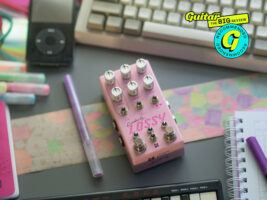
Chase Bliss Lossy review – dial-up internet never sounded so good
$399/€469, chasebliss.com
Most of the people reading this will be old enough to get a bit nostalgic about the early 2000s – or as you might remember it if you’re over the age of 35 ‘yesterday’. Yes, from baggy jeans and sweepy haircuts to dial-up internet and Limewire, the 2000s nostalgia is back and it’s cool again, grandpa.
READ MORE: Chase Bliss Generation Loss MkII review: A digital effect to make everything sound extra-analogue
It’s the perfect moment then, for two of the most innovative companies in their respective fields – pedal geniuses Chase Bliss and plugin savants Goodhertz – to make the ‘bad’ audio artefacts of our youths into something musical. Have they achieved it? Let’s find out.
Is the Chase Bliss Lossy easy to use?
Before we begin, a reminder that Chase Bliss is peerless as a modern and defiantly different effects brands that has got to where it is today by creating pedals that will push you to think outside of the box.
To do that, things tend to get a little weird, and the desire to maximise the creative experience comes at the expense of and plug and play considerations. Simply put and if you didn’t know already, this is a pedal that will require a fairly hefty amount of manual reading and experimentation to get the best out of – as is the case with most Chase Bliss pedals.
With that in mind then, and presuming that you’re the sort of person prepared to sign up to the above, let’s get to know Lossy.
Chase Bliss Lossy front
What is the Chase Bliss Lossy?
Remember those low-quality, sketchy mp3s I was talking about up top? Well, in essence that’s what we’re talking about here. The original Lossy started life as a plugin released back in 2015 by Goodhertz, and its stated mission was to allow you to imbue your sounds with all the digital low-fidelity imperfections that came when crushing a waveform small enough to fit the 64kbps codec, or of a degraded video call in the earliest days of Skype.
Goodhertz’s main goal with this plugin was to “make it easy to recreate the sound of a bad mp3 in real-time, without having to bounce a track to and from an mp3.” Lossy has been used by various artists in the years since, most notably by Phoebe Bridgers on the track Savior Complex from her Grammy-nominated Punisher LP.
For most guitar players, having something in plugin format is all well and good – but what happens when we want to create that effect in real-time? Enter then, Chase Bliss. The Lossy pedal not only encapsulates everything that people loved about the original’s lofi sound, but also adds a bunch of new features to enhance the real-time experience, such as a built-in limiter, evolving spectral freeze, and two new modes – all-wet and slow.
What does the Chase Bliss Lossy sound like?
While I mentioned that a certain degree of manual consultation is needed to really get the best out of the Lossy, you shouldn’t let the trademark rack of dip switches on the top scare you – like all Chase Bliss pedals, it’s not as daunting as that might make it seem.
The trick to getting the best out of Lossy is to understand the ebb and flow between the three different Modes (inverse, standard and phase jitter) and the Packets, which “introduce unpredictability and motion”.
Being the millennial that I am, I decided to use my Squier Classic Vibe Starcaster plugged into my Fender 68’ Custom Deluxe Reverb to channel Kid A era nostalgia. Starting with everything at noon, I set the Mode control to ‘phase jitter’ and the Packet to repeat and I was instantly greeted with a sound akin to Jonny Greenwood being channelled through dial-up modem.
Chase Bliss Lossy close-up
As with most Chase Bliss pedals, even controls that seem straightforward aren’t – as typified by the Verb control. You might assume that this is just a reverb, and you’d be correct… but also not. It doesn’t sound like a typical reverb – the sort you’d hear in any real-life situation – instead it’s more like the ugly echo you’d hear trailing out on a bad Zoom call. It’s not for everyone, but for creating these lo-fi digital soundscapes, it’s absolutely perfect.
Lossy’s new freeze function is the crowning achievement of the pedal format however – it’s the place where I find myself getting lost in a world of sonic exploration. Though a freeze mode is quite a common one that you see on a fair few pedals now (not least EHX’s pedal of the same name) but Lossy’s take – affectionately dubbed ‘Slushy’ – is something else entirely.
Slushy updates and adapts the frozen sound to your playing in real-time, allowing you to create beautiful synth-like pads that constantly evolve and adapt without ever overshadowing what you’re playing. It’s that classic ‘you could use this pedal to start an entire band’ thing.
Chase Bliss Lossy dip switches
Is the Chase Bliss Lossy worth it?
Other brands have tried to put a plugin in pedal form and the results are often left feeling exactly that – a strange marriage of two worlds that don’t entirely work together. The Lossy is different. It’s a testament to Chase Bliss’s engineering team and its willingness to collaborate with others that this feels like its own thing, both a faithful replication of the original plugin but at the same time every bit a guitar pedal.
It’s also a reminder that Chase Bliss pedals are far more than just impressive technical exercises – they are inspirational musical devices that push you into new and previously uncharted musical territory, far beyond the boundaries of Y2K.
Like this? Try these
Chase Bliss Generation Loss MKII
Kinotone Ribbons
Fairfield Circuitry Shallow Water
The post Chase Bliss Lossy review – dial-up internet never sounded so good appeared first on Guitar.com | All Things Guitar.
Source: www.guitar-bass.net













